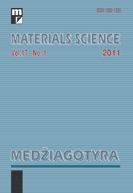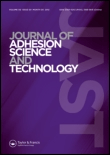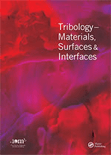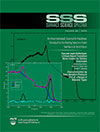
China Surface Engineering
Scope & Guideline
Exploring innovations in coatings and films.
Introduction
Aims and Scopes
- Surface Coatings and Treatments:
This area includes research on the development, application, and characterization of various surface coatings such as thermal barrier coatings, anti-corrosive coatings, and superhydrophobic surfaces. The focus is on improving mechanical, chemical, and tribological properties. - Tribological Performance:
The journal regularly publishes studies examining the friction and wear properties of materials and coatings under different conditions. This includes investigations into the mechanisms of wear, lubrication, and the effects of surface textures on tribological behavior. - Material Modification and Enhancement:
Research on modifying the properties of materials through techniques such as laser cladding, plasma spraying, and surface texturing is a core focus. This includes exploring the effects of different alloy compositions and structures on performance. - Corrosion Resistance:
The journal emphasizes studies aimed at understanding and improving the corrosion resistance of materials in aggressive environments. This includes the study of electrochemical behaviors and the development of protective coatings. - Nanotechnology in Surface Engineering:
Recent contributions highlight the application of nanotechnology in enhancing surface properties, including the development of nanoscale coatings and composite materials that exhibit superior performance.
Trending and Emerging
- Self-healing Coatings:
Research on self-healing coatings is gaining momentum, driven by the demand for materials that can autonomously repair damage and extend their service life, particularly in harsh environments. - Smart and Responsive Coatings:
There is an increasing focus on coatings that respond to environmental stimuli, such as temperature, pH, or light. These smart coatings are designed for applications in diverse fields, including biomedical and aerospace. - Advanced Laser Processing Techniques:
Innovative laser processing methods, such as laser shock peening and ultrafast laser treatments, are emerging as popular topics, showcasing their effectiveness in enhancing material properties and performance. - Biocompatible and Antimicrobial Coatings:
With the growing interest in healthcare applications, there is a trend towards developing coatings that are biocompatible and possess antimicrobial properties, particularly for implants and medical devices. - Big Data and Machine Learning in Surface Engineering:
The integration of big data analytics and machine learning techniques in surface engineering research is on the rise, facilitating the optimization of processes and properties through data-driven approaches.
Declining or Waning
- Traditional Coatings without Advanced Modifications:
Research on conventional coatings that lack innovative approaches or enhancements is seeing less interest. The focus has shifted towards more advanced, multifunctional coatings that provide enhanced performance. - Basic Corrosion Studies:
While corrosion resistance remains a key topic, studies that merely describe corrosion phenomena without proposing novel solutions or treatments are becoming less frequent. - Generalized Surface Treatment Techniques:
There is a noticeable decline in publications focused on generalized surface treatment methods that do not incorporate specific applications or advanced technologies, as researchers seek more targeted and innovative approaches.
Similar Journals

International Journal of Corrosion and Scale Inhibition
Unveiling Insights into Corrosion DynamicsInternational Journal of Corrosion and Scale Inhibition (ISSN: 2305-6894, E-ISSN: 2305-6894), published by VSEROSSIISKAYA ASSOTSIATSIYA KORROZIONISTOV, is a distinguished open-access journal dedicated to advancing knowledge in the critical fields of corrosion science and material degradation processes. Established in 2012, this journal serves as a vital platform for researchers, professionals, and students aiming to explore innovative solutions to corrosion-related challenges across diverse industries. Located in the Russian Federation, it boasts commendable rankings, placing it in the Q2 category for both Materials Chemistry and Metals and Alloys, signifying its significant impact within the scientific community. With a robust Scopus ranking—a commendable 40th out of 176 in Materials Science for Metals and Alloys and 120th out of 317 in Materials Chemistry—the journal highlights its pivotal role in disseminating research that shapes the future of material durability and sustainability. By fostering open access to scholarly work, the journal ensures that critical findings are accessible to a broad audience, thereby promoting knowledge sharing and collaboration in the quest to mitigate corrosion and enhance material performance.

Materials Physics and Mechanics
Exploring the Mechanics of Tomorrow's MaterialsMaterials Physics and Mechanics is a pivotal journal dedicated to advancing the fields of condensed matter physics, materials science, mechanical engineering, and the mechanics of materials. Published by the Institute of Problems in Mechanical Engineering, Russian Academy of Sciences, this journal has established itself as a valuable resource since its inception, particularly from 2003 to 2004 and now continuously from 2009 to 2024. Although it currently holds a Q4 categorization in various disciplines, its contributions are critical to understanding and developing new materials and their applications in engineering. The journal provides insightful articles that explore the nuances of material properties, their behaviors under different conditions, and the physical principles governing these phenomena. Though it operates under a traditional publication model, the insights provided within its pages are invaluable to researchers, professionals, and students striving to push the boundaries of knowledge in the materials domain. Its ISSN numbers (1605-2730, E-ISSN 1605-8119) serve as a gateway to a wealth of scientific knowledge emanating from the Russian Federation, contributing to the global discourse in materials physics and mechanics.

Korean Journal of Metals and Materials
Exploring the Intersection of Metals and TechnologyWelcome to the Korean Journal of Metals and Materials, a premier publication dedicated to advancing research in the interdisciplinary fields of metals and materials science. Published by the Korean Institute of Metals and Materials, this journal aims to foster the dissemination of innovative findings and significant developments across various domains, including electronic, optical, and magnetic materials, metals and alloys, as well as modeling, simulation, and surface coatings. With a commendable Q3 quartile ranking in several relevant categories as of 2023, it serves as a vital resource for researchers, professionals, and students interested in the latest scientific trends and technological applications. The journal has successfully converged from 2007 to 2024, showcasing a rich archive of knowledge. Engaging with this publication gives readers the opportunity to stay updated with critical advancements and enhances collaboration within the vibrant materials science community. Access is available through various platforms, ensuring that our content is widely accessible to all those striving for excellence in the field.

International Journal of Surface Science and Engineering
Shaping the Future of Coatings and MaterialsThe International Journal of Surface Science and Engineering, published by INDERSCIENCE ENTERPRISES LTD, serves as a vital platform for researchers and professionals in the field of mechanical engineering, surfaces, coatings, and materials science. With an ISSN of 1749-785X and an E-ISSN of 1749-7868, this journal disseminates innovative research addressing the challenges and advancements in surface technologies and engineering practices. Its scope includes, but is not limited to, surface coatings, interface properties, and novel material applications. Since its inception in 2007, the journal has established a solid reputation, achieving a Q3 ranking in Mechanical Engineering and Surfaces, Coatings and Films, and a Q4 ranking in Surfaces and Interfaces as of 2023. These metrics underscore the journal's growing influence, despite being positioned within the Q3 and Q4 quartiles of its categories. The International Journal of Surface Science and Engineering provides a curated collection of high-quality articles that contribute significantly to the understanding of surface phenomena, fostering collaboration and advancements in the field. Researchers, professionals, and students alike will find this journal an indispensable resource for cutting-edge developments and in-depth analyses.

Materials Science-Medziagotyra
Exploring Innovative Materials for a Sustainable FutureMaterials Science-Medziagotyra is a prominent peer-reviewed journal dedicated to the field of materials science, published by Kaunas University of Technology in Lithuania. Since its transition to an Open Access model in 2012, it has facilitated broad dissemination of research findings, enhancing accessibility for researchers and professionals worldwide. This journal is indexed in Scopus and has consistently contributed to the academic community with a focus on innovative materials and their applications, ranking in the Q3 category of Materials Science (miscellaneous) as of 2023. With the responsibility of synthesizing substantial research from 2008 through 2024, Materials Science-Medziagotyra aims to bridge gaps in material research while fostering collaboration among scientists, students, and industry leaders. Its commitment to quality and rigor in scientific discourse underscores its relevance and importance in advancing the field.

JOURNAL OF ADHESION SCIENCE AND TECHNOLOGY
Driving Interdisciplinary Collaboration in Adhesion Research.Journal of Adhesion Science and Technology is a distinguished publication within the fields of Chemistry, Materials Science, and Engineering, published by the reputable Taylor & Francis Ltd. Since its inception in 1987, the journal has been pivotal in advancing the understanding of adhesion mechanisms, technologies, and applications, boasting a conversion period extending to 2024. With a commendable impact factor and rankings placed in the Q2 category across various relevant domains, including Mechanics of Materials and Materials Chemistry, it offers a robust platform for scholars and practitioners alike. While currently not an open-access journal, it provides multiple access options, ensuring that vital research in adhesion science remains accessible to those dedicated to innovation and practical improvements in material interactions. This journal not only promotes empirical research but also encourages interdisciplinary collaboration, making it essential reading for researchers, industry professionals, and students eager to contribute to this dynamic field.

Tribology-Materials Surfaces & Interfaces
Advancing tribological knowledge for a sustainable future.Tribology-Materials Surfaces & Interfaces is a leading journal dedicated to advancing the field of tribology, leveraging insights into materials, surfaces, and interface interactions. Published by SAGE Publications Inc in the United Kingdom, this journal plays a pivotal role in disseminating high-quality research, providing a platform for both foundational and applied studies in mechanical engineering and materials science. With an impact factor reflecting its significance, ranking in the third quartile for both Materials Science and Mechanical Engineering, it caters to a diverse audience including researchers, industry professionals, and students. Although it currently does not offer open access, the journal endeavors to periodically review and publish innovative studies that enhance understanding of tribological phenomena, thereby contributing to the development of advanced materials and engineering solutions. Since its inception in 2007, Tribology-Materials Surfaces & Interfaces has consistently presented cutting-edge findings, thereby cementing its position as an essential resource for anyone engaging in tribological research.

Journal of Materiomics
Advancing Knowledge in Electronic, Optical, and Magnetic MaterialsThe Journal of Materiomics, published by Elsevier, stands at the forefront of research in the interdisciplinary fields of materials science, particularly focusing on Electronic, Optical and Magnetic Materials, Metals and Alloys, and Surface Coatings and Films. Since its inception in 2015, this Open Access journal has fostered innovative research and theoretical advancements, facilitating the dissemination of knowledge with a global audience. With an impressive impact factor and consistently ranked in the top tiers of its categories — notably Q1 in 2023 for all its major focus areas, the journal positions itself as a vital resource for researchers, professionals, and students seeking to explore cutting-edge developments in materials science. Based in Amsterdam, Netherlands, the journal encourages the rigorous investigation of material interactions at the nanoscale, fostering advancements that underscore the applicability of materials across various industries. By providing a platform for high-quality research, the Journal of Materiomics plays a critical role in shaping the future of material technologies.

Surface Innovations
Connecting Scientists for Groundbreaking DiscoveriesSurface Innovations, an esteemed journal published by Emerald Group Publishing Ltd, serves as a crucial platform for researchers and professionals working within the fields of Materials Chemistry, Process Chemistry and Technology, and Surfaces, Coatings and Films. Launched in 2013, this journal has garnered attention for its commitment to advancing knowledge and innovation, holding a distinguished Q3 ranking in multiple categories as of 2023. With a focus on the latest methodologies and applications in surface science, Surface Innovations not only facilitates the dissemination of cutting-edge research but also encourages interdisciplinary collaboration among scientists and engineers. While not an open-access journal, it offers numerous options for accessibility to engage a wide array of audiences, making it a valuable resource for those looking to expand their understanding and expertise in this rapidly evolving field. The journal's consistent inclusion in high-ranking Scopus categories further underscores its academic impact and relevance.

Surface Science Spectra
Exploring the Depths of Surface PhenomenaSurface Science Spectra is a critically acclaimed journal published by AIP Publishing, serving as an essential resource in the fields of Condensed Matter Physics, Surfaces and Interfaces, and Surfaces, Coatings and Films. With an ISSN of 1055-5269 and an E-ISSN of 1520-8575, this peer-reviewed journal provides a platform for sharing innovative research and groundbreaking findings, contributing to a deeper understanding of surface phenomena and their applications. While the journal operates under a traditional subscription model, its impact is recognized in its 2023 rankings where it holds a Q3 category in both Condensed Matter Physics and Surfaces and Interfaces, and a Q2 category in Surfaces, Coatings and Films. The journal has been publishing since 1992 and continues to attract contributions from leading researchers worldwide. With an emphasis on high-quality research articles, Surface Science Spectra is committed to advancing knowledge in material science and engineering, making it an indispensable reference for scholars, industry professionals, and students alike.